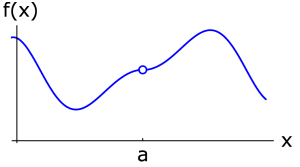目录
Limits & Continuity
MITx: 18.01.1x Calculus 1A notes
极限是什么?
理解极限可以从无穷数列开始。
我们在高中的时候见过不少的无穷数列。其中的一些无穷数列收敛于一个实数 $L$。我们通常把 $L$ 称为该数列的极限。
而数列本身可以看做是自然数到实数 $N \to L$ 的一个函数;因此我们就可以把极限的概念从数列转到函数上:当函数的自变量 $n$ 趋近于 $\infty^+$ 的时候,$f(n)$的值无限趋近于 $L$。
在刚提到的无穷数列所表达的函数中, 数列函数的自变量 $n$ 是无限趋近于 $\infty^+$ 的。我们来试想一下如果 $n$ 的值无限趋近于一个数列上某一个点 $a$ 的情况下,那么函数的极限又会怎么样呢?
结果很好猜测。我们把 $a$ 代入函数,得到的结果是 $f(a)$。因此不难得出,当 $n \to a$ 的时候,是有 $f(x) -> f(n)$的。
看起来好像 $f(n)$ 应该是数列在 $a$ 点的极限了。不过这里又有另外一个问题。在数列中,我们的 $n$ 到底是在 $a$ 的左边还是右边?这两种可能性导致了我们需要考虑两种情况:$n$ 从左边或者右边无限趋近于 $a$,也就是说,我们的 $f(n)$ 也有两种情况,即在 $a$ 的左边或者右边。因此,对数列上的一个点我们实际上有两个极限:左极限和右极限。
左极限和右极限
根据上面的推理我们可以描述一下左极限和右极限的定义:
右极限可以被定义为:
Suppose $f(x)$ gets really close to $R$ for values of $x$ that get really close to (but are not equal to) a from the right. Then we say $R$ is the right-hand limit of the function $f(x)$ as $x$ approaches $a$ from the right.
记做:$\displaystyle {\lim _{x\rightarrow \mathbf{a^+}} f(x) = R}$
左极限的定义类似:
If $f(x)$ gets really close to $L$ for values of $x$ that get really close to (but are not equal to) a from the left, we say that $L$ is the left-hand limit of the function $f(x)$ as $x$ approaches a from the left.
记做:$\displaystyle {\lim _{x\rightarrow \mathbf{a^-}} f(x) = L}.$
极限是否存在?
判断一个极限是否存在,首先要明白:函数 $f(x)$ 在 $a$ 点的极限,指的是当 $x$ 从左右同时趋近于 $a$ 时的极限。只有当 $f(x)$ 在 $a$ 点的左极限和右极限存在且相等时候,我们才说,函数的极限存在: $$ \displaystyle {\lim _{x\rightarrow a^+} f(x)} = \displaystyle {\lim _{x\rightarrow a^-} f(x)} = L $$ then $$ \displaystyle {\lim _{x\rightarrow a} f(x) = L} $$
其他可能极限不存在的情况
- 左极限和右极限存在,但不相等
- 左右极限可能趋向于无穷大,无穷小
- 左右极限可能会在某个区间内震荡(比如 sinx)
极限的定义
我们也来看看正式的数学定义:
For all $ε>0$, there exists some $δ>0$ such that if $0<|x−a|<δ$, then $|f(x)−L|<ε$.
ε和δ
来看看这个公式里都有什么新的:$ε$, $δ$。这两个量是作为距离的描述:
- $ε$ 描述 $f(x)$ 到 $L$ 的距离 。
- $δ$ 描述 $x$ 离 $a$ 的距离。
总的来说,这两个量用于描述一个非常小的距离:
- $0<|x−a|<δ$ 代表 $x$ 到 $a$ 的距离处于一个非常小的范围 $δ$ 内。
- 同理,$|f(x)−L|<ε$ 表明 $f(x)$ 到 $L$ 的距离也处于一个非常小的范围 $ε$ 内
证明极限存在需要满足上述的这两个表达中的:
- $ε$ 可以是任意值
- $ε$ 可以通过任意的,与 $a$ 点距离小于 $δ$ 的 $x$ 来满足,也就是通过 $x$ 总是可以得到 $f(x)$,其与极限值 $L$ 的距离始终小于 $ε$。
极限的运算法则
极限可以做 +、-、*、/ 运算。
假设我们有:$\displaystyle {\lim _{x\rightarrow a} f(x) = L}$,$\displaystyle {\lim _{x\rightarrow a} g(x) = M}:$,则:
- $\displaystyle {\lim _{x\rightarrow a} \left[f(x)+g(x)\right] }$ $=$ $L+M$:和的极限是极限的和。
- $\displaystyle {\lim _{x\rightarrow a} \left[f(x)-g(x)\right] }$ $=$ $L-M$:差的极限是极限的差。
- $\displaystyle {\lim _{x\rightarrow a} \left[f(x)\cdot g(x)\right] }$ $=$ $L\cdot M$:乘积的极限是极限的乘积
简单证明
(以加法为例子):
假设有 $\displaystyle {\lim _{x\rightarrow a} f(x) = L}$ 和 $\displaystyle {\lim _{x\rightarrow a} g(x) = M},$,可知:
\[
\begin{align*}
f(x) = L + \varepsilon_1 \\
g(x) = M + \varepsilon_2 \\
\end{align*}
\]
因此,有 $$f(x) + g(x) = L + M + \varepsilon_1 + \varepsilon_2$$
当 $x \to a$ 时,$\varepsilon_1, \varepsilon_2 \to 0$,因此
$$\displaystyle {\lim _{x\rightarrow a} \left[f(x)+ g(x)\right] } = L + M$$
同理可证其他的极限定理。
连续
当在 $x=a$ 的时候,如果有 $\displaystyle {\lim _{x\rightarrow a} f(x) } = f(a)$,则我们称函数 $f(x)$ 在点 $a$ 处连续(Continuous)。显然,$f(x)$ 在 $a$ 处连续时,极限是非常好计算的。
连续也分左右:
- 如果 $\displaystyle {\lim _{x\rightarrow a^+} f(x) } = f(a)$,那么我们称 $f(x)$ 在 $a$ 点右连续。
- 如果 $\displaystyle {\lim _{x\rightarrow a^-} f(x) } = f(a)$,那么我们称 $f(x)$ 在 $a$ 点左连续。
Overall continuity
如果函数 $f$ 在其定义域上的所有点都连续,则称该函数 $f$ 是连续的。这种类型的连续也被称为 Overall continuity。
- 常见的连续函数有:
- 所有的多项式
- $\cos x$ 和 $\sin x$
- $a^x$ 当 $a > 0$
- $\sqrt [3]{x}$,$|x|$
- 带条件的常见连续函数有:
- $\log _{a} x$ 当 $a > 0$、$x > 0$
- $\tan x$ 在所有定义过的 $x$ 上
- $\sqrt {x}$ 当 $x>0$。
Limit Laws and Continuity
上面的函数很多都可以表示为函数运算的的形式。我们可以利用来证明函数连续性是与单个函数的连续性相关(以乘法为例子):
假设有$f(a)$, $f(b)$ 在实数定义域上连续。根据连续的定义,可得:$ \displaystyle {\lim _{x\to a} f(x) } = f(a)$ 且 $\displaystyle {\lim _{x\to b} f(x) } = f(b)$。
由 $ \displaystyle{\lim _{x\rightarrow a} \left[f(a)\cdot g(b)\right] } = {\lim _{x\to a}f(a) \cdot {\lim _{x\rightarrow b}f(b) } = f(a) \cdot f(b) }$,可知复合函数$f(a) \cdot f(b)$ 也是连续的。该证明可以推广到加法和减法,以及复合函数。
除法的话,只在 $f/g$ 有定义的区域连续。
不连续的种类
当然,如果$\displaystyle {\lim _{x\rightarrow a} f(x) }$ 或者 $f(a)$ 不存在,那么很显然 $f(x)$ 在 $a$ 点是不连续的。而不连续(Discontinuity)大概分两种种类:Jump discontinuity 和 Removable discontinuity 。
如果 $f(x)$ 在点 $a$ 的左右极限都存在但是不相等,我们就称 $f(x)$ 在点 $a$ 是 Jump discontinuity。

如果 $f(x)$ 在点 $a$ 的左右极限都存在且相等,但 $f(a)$ 不存在,我们就称 $f(x)$ 在点 $a$ 是 Removable discontinuity。

介值定理
介值定理(Intermediate Value Theorem)的定理如下:
If f is a function which is continuous on the interval $[a,b]$, and $M$ lies between the values of $f(a)$ and $f(b)$, then there is at least one point $c$ between $a$ and $b$ such that $f(c)=M$.
$f(c)=M$ 意味着 $f$ 与 $M$ 代表的直线相交。那么这样就好理解了,如果有两个点分别处于 $y=M$ 的上下方,且通过该两点的函数是连续的,则该函数必与 $M$ 必至少有一个交点。
几个需要注意的点:
- 区间的限定:$[a,b]$,也就是 $f$ 在 $a$ 点右连续,在$b$点左连续,在 $[a,b]$ 上连续
- 我们通常令 $M = 0$, 这样函数就成为了一个方程了。只要该函数在某个区域连续,且该区域内两点处函数值一正一副,那么该方程在该区域内必然有根。
- 介值定理只能应用于连续的函数上,而介值定理也只能判定根的存在性,并不能判定根的具体数量。
IVT 只能应用在实数范围内。也就是说,只有实数范围才能确保函数的连续性;如果限制该范围,比如说有理数的范围,则某一些点将会被跳过(比如 $e$, $pi$,无理数等等)。这种情况下,函数是离散的,因此我们不能确保该函数一定会与 $y=M$ 相交。
极限与商
极限的商分好几种情况:
- 如果 $M \ne 0$, 则 $\displaystyle { \lim _{x\rightarrow a} \frac{f(x)}{g(x)} = \frac{L}{M}}$
- 如果 $M=0$ 但 $L \ne 0$, 则 $\displaystyle {\lim _{x\rightarrow a} \frac{f(x)}{g(x)}}$ 不存在(DNE)。
- 如果$M=0$ 且 $L=0$, 则 $\displaystyle {\lim _{x\rightarrow a} \frac{f(x)}{g(x)}}$ 可能存在,也可能不存在,需要进一步的判断(比如对多项式做因式分解)。
极限求解的解决方案
分母分子都不为 0
如果函数是连续的,直接求分母分子在该点的值即可。该值等于函数在该点的极限,相除之后则是结果,比如:
$$\displaystyle {\lim _{x\rightarrow 0} \frac{x^+2x-3}{x^2-3x+2} } = \frac{-3}{2}$$
0/0的情况
可以采取的策略是,简化函数,使其满足分子分母都不为 0 的形式,比如多项式可以通过因式分解: $$ \begin{align*} \displaystyle {\lim _{x\rightarrow 1} \frac{x^2+2x-3}{x^2-3x+2} } &= {\lim _{x\rightarrow 1} \frac{(x-1)(x+3)}{(x-1)(x-2)} } \\ &= {\lim _{x\rightarrow 1} \frac{x+3}{x-2} } \\ &= 4 \end{align*} $$ 如果简化的情况转移到了第二种 $0/~0$ 的情况,则极限不存在。
DNE 的不同情况
某些函数的极限可以归类到无穷大 / 无穷小的情况。这种情况下,如果希望知道函数极限的趋势,那么需要从左和右趋近点,来看 overall limit 是否会有一个总的趋势。如果两个方向的趋势不同,则极限不存在。